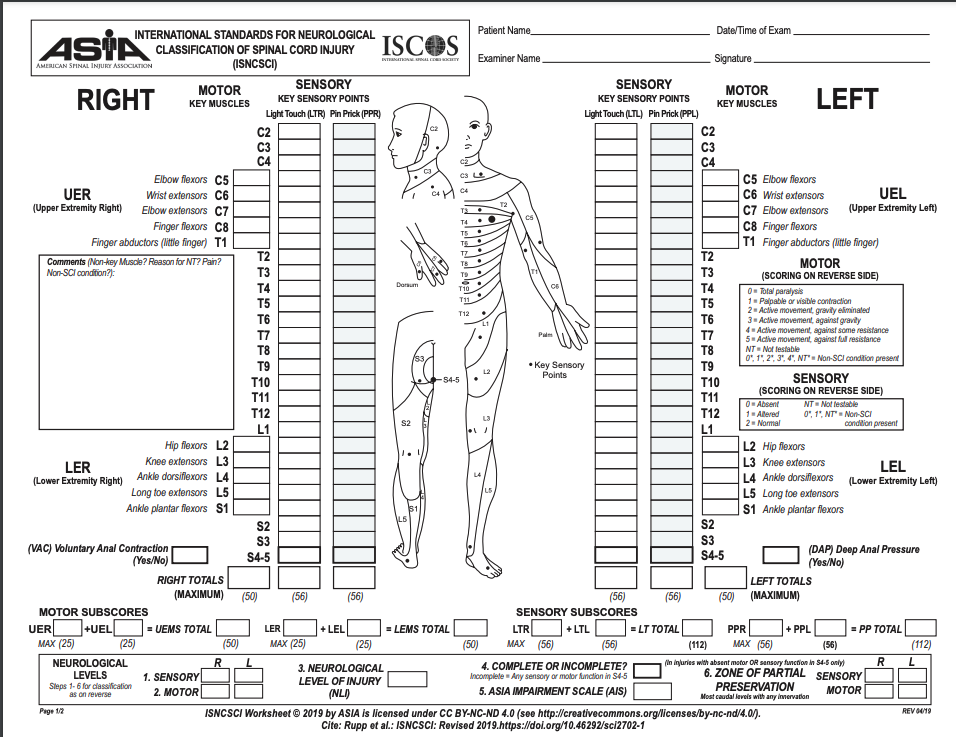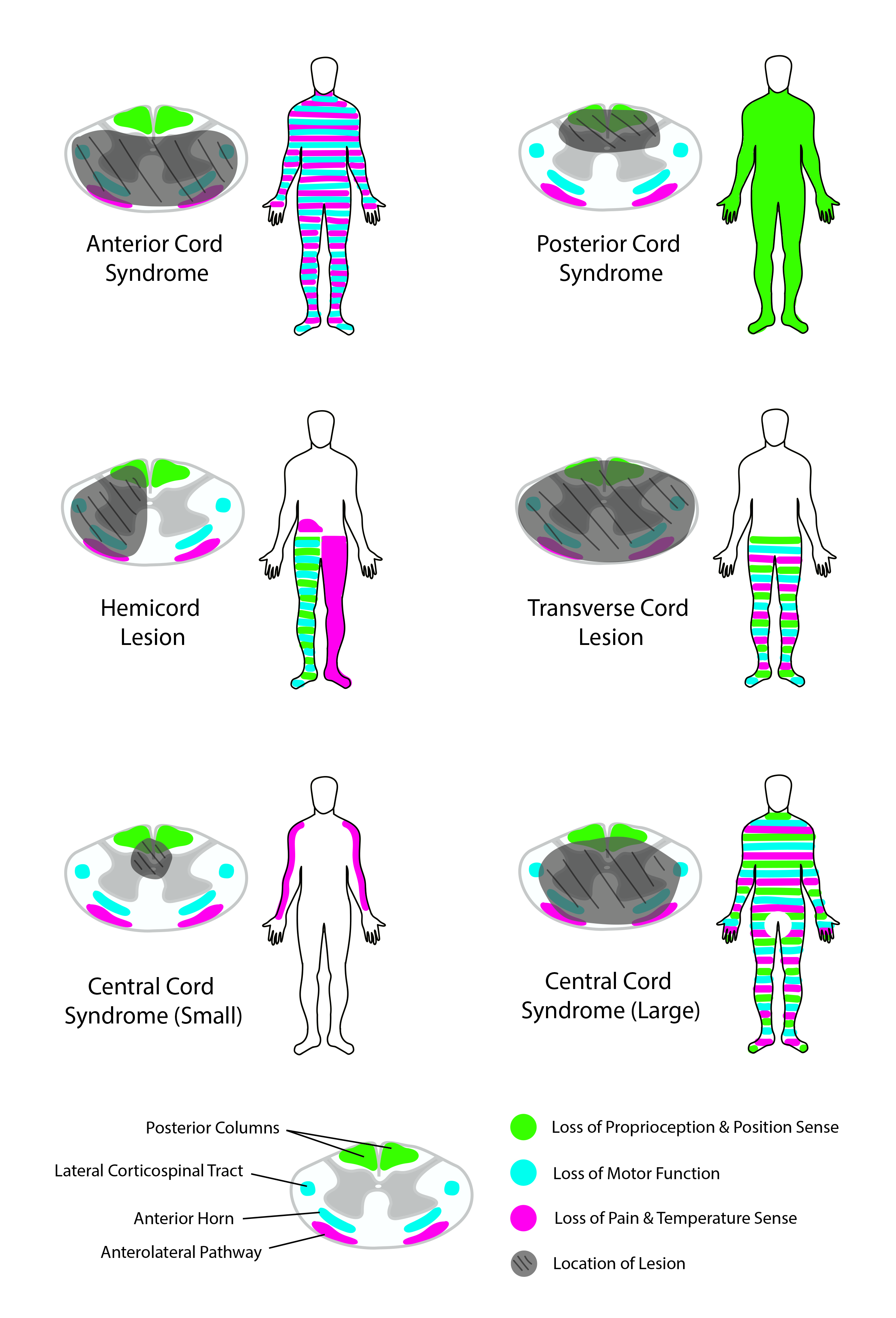[2]
Spinal Cord Injury (SCI) 2016 Facts and Figures at a Glance. The journal of spinal cord medicine. 2016 Jul
[PubMed PMID: 27471859]
[3]
Varma AK,Das A,Wallace G 4th,Barry J,Vertegel AA,Ray SK,Banik NL, Spinal cord injury: a review of current therapy, future treatments, and basic science frontiers. Neurochemical research. 2013 May
[PubMed PMID: 23462880]
[4]
McDaid D,Park AL,Gall A,Purcell M,Bacon M, Understanding and modelling the economic impact of spinal cord injuries in the United Kingdom. Spinal cord. 2019 Sep
[PubMed PMID: 31086273]
Level 3 (low-level) evidence
[5]
Alizadeh A,Dyck SM,Karimi-Abdolrezaee S, Traumatic Spinal Cord Injury: An Overview of Pathophysiology, Models and Acute Injury Mechanisms. Frontiers in neurology. 2019
[PubMed PMID: 30967837]
Level 3 (low-level) evidence
[6]
Kirshblum SC,Biering-Sorensen F,Betz R,Burns S,Donovan W,Graves DE,Johansen M,Jones L,Mulcahey MJ,Rodriguez GM,Schmidt-Read M,Steeves JD,Tansey K,Waring W, International Standards for Neurological Classification of Spinal Cord Injury: cases with classification challenges. The journal of spinal cord medicine. 2014 Mar;
[PubMed PMID: 24559416]
Level 3 (low-level) evidence
[7]
Kirshblum SC,Burns SP,Biering-Sorensen F,Donovan W,Graves DE,Jha A,Johansen M,Jones L,Krassioukov A,Mulcahey MJ,Schmidt-Read M,Waring W, International standards for neurological classification of spinal cord injury (revised 2011). The journal of spinal cord medicine. 2011 Nov;
[PubMed PMID: 22330108]
[8]
Waring WP 3rd,Biering-Sorensen F,Burns S,Donovan W,Graves D,Jha A,Jones L,Kirshblum S,Marino R,Mulcahey MJ,Reeves R,Scelza WM,Schmidt-Read M,Stein A, _ 2009 review and revisions of the international standards for the neurological classification of spinal cord injury. The journal of spinal cord medicine. 2010
[PubMed PMID: 21061894]
[10]
Roth EJ,Park T,Pang T,Yarkony GM,Lee MY, Traumatic cervical Brown-Sequard and Brown-Sequard-plus syndromes: the spectrum of presentations and outcomes. Paraplegia. 1991 Nov;
[PubMed PMID: 1787982]
[12]
Roberts TT,Leonard GR,Cepela DJ, Classifications In Brief: American Spinal Injury Association (ASIA) Impairment Scale. Clinical orthopaedics and related research. 2017 May
[PubMed PMID: 27815685]
[14]
Kumar Y,Hayashi D, Role of magnetic resonance imaging in acute spinal trauma: a pictorial review. BMC musculoskeletal disorders. 2016 Jul 22;
[PubMed PMID: 27448661]
[15]
Wilson JR,Grossman RG,Frankowski RF,Kiss A,Davis AM,Kulkarni AV,Harrop JS,Aarabi B,Vaccaro A,Tator CH,Dvorak M,Shaffrey CI,Harkema S,Guest JD,Fehlings MG, A clinical prediction model for long-term functional outcome after traumatic spinal cord injury based on acute clinical and imaging factors. Journal of neurotrauma. 2012 Sep
[PubMed PMID: 22709268]
[16]
Liu Q,Liu Q,Zhao J,Yu H,Ma X,Wang L, Early MRI finding in adult spinal cord injury without radiologic abnormalities does not correlate with the neurological outcome: a retrospective study. Spinal cord. 2015 Oct
[PubMed PMID: 25777331]
Level 2 (mid-level) evidence
[17]
Chandra J,Sheerin F,Lopez de Heredia L,Meagher T,King D,Belci M,Hughes RJ, MRI in acute and subacute post-traumatic spinal cord injury: pictorial review. Spinal cord. 2012 Jan
[PubMed PMID: 22064660]
[18]
Rouanet C,Reges D,Rocha E,Gagliardi V,Silva GS, Traumatic spinal cord injury: current concepts and treatment update. Arquivos de neuro-psiquiatria. 2017 Jun;
[PubMed PMID: 28658409]
[19]
Jendelova P, Therapeutic Strategies for Spinal Cord Injury. International journal of molecular sciences. 2018 Oct 16
[PubMed PMID: 30332844]
[20]
Wu JC,Huang WC,Chen YC,Tu TH,Tsai YA,Huang SF,Huang HC,Cheng H, Acidic fibroblast growth factor for repair of human spinal cord injury: a clinical trial. Journal of neurosurgery. Spine. 2011 Sep
[PubMed PMID: 21663406]
[21]
Freund P,Schmidlin E,Wannier T,Bloch J,Mir A,Schwab ME,Rouiller EM, Nogo-A-specific antibody treatment enhances sprouting and functional recovery after cervical lesion in adult primates. Nature medicine. 2006 Jul
[PubMed PMID: 16819551]
[22]
Geisler FH,Dorsey FC,Coleman WP, Recovery of motor function after spinal-cord injury--a randomized, placebo-controlled trial with GM-1 ganglioside. The New England journal of medicine. 1991 Jun 27
[PubMed PMID: 2041549]
Level 1 (high-level) evidence
[23]
Pitts LH,Ross A,Chase GA,Faden AI, Treatment with thyrotropin-releasing hormone (TRH) in patients with traumatic spinal cord injuries. Journal of neurotrauma. 1995 Jun
[PubMed PMID: 7473798]
[24]
Lee JH,Roy J,Sohn HM,Cheong M,Liu J,Stammers AT,Tetzlaff W,Kwon BK, Magnesium in a polyethylene glycol formulation provides neuroprotection after unilateral cervical spinal cord injury. Spine. 2010 Nov 1
[PubMed PMID: 20938394]
[25]
Casha S,Zygun D,McGowan MD,Bains I,Yong VW,Hurlbert RJ, Results of a phase II placebo-controlled randomized trial of minocycline in acute spinal cord injury. Brain : a journal of neurology. 2012 Apr
[PubMed PMID: 22505632]
Level 1 (high-level) evidence
[26]
Tate DG,Kalpakjian CZ,Forchheimer MB, Quality of life issues in individuals with spinal cord injury. Archives of physical medicine and rehabilitation. 2002 Dec
[PubMed PMID: 12474168]
Level 2 (mid-level) evidence
[27]
Hancock KM,Craig AR,Dickson HG,Chang E,Martin J, Anxiety and depression over the first year of spinal cord injury: a longitudinal study. Paraplegia. 1993 Jun
[PubMed PMID: 8336997]



